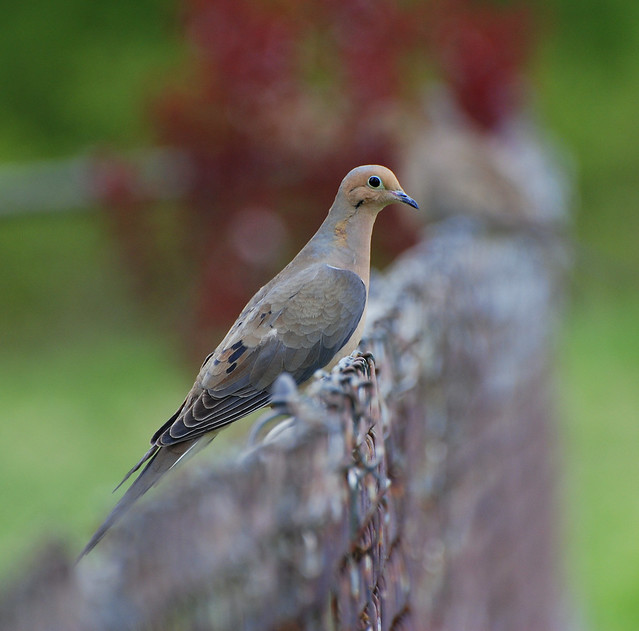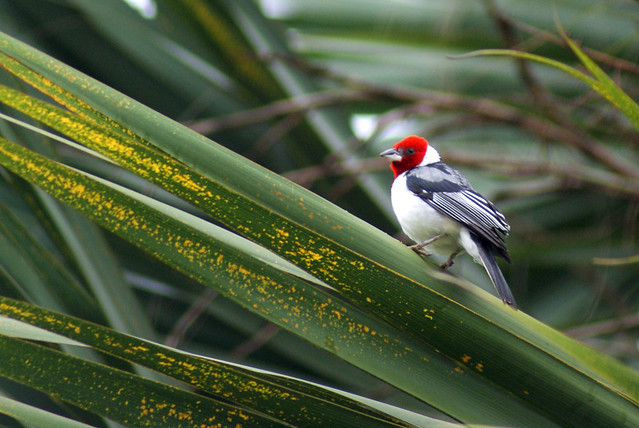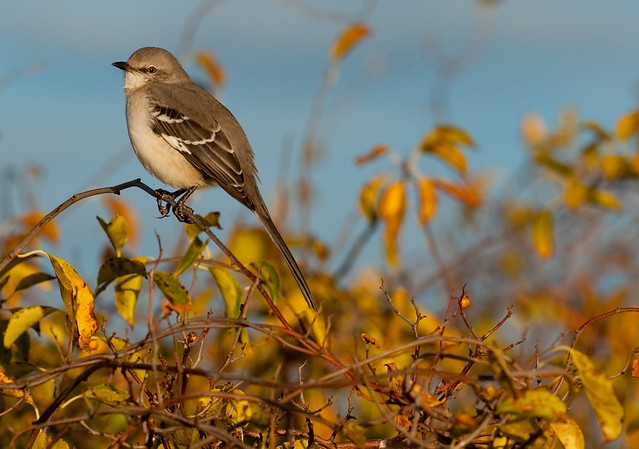 Alpine Accentor (Prunella collaris). Guijo de Santa Bárbara, Cáceres. 06-03-2011. Raúl Guzmán.
Alpine Accentor (Prunella collaris). Guijo de Santa Bárbara, Cáceres. 06-03-2011. Raúl Guzmán.
A list of the most notable records sent to the GOCE forum in March 2011 (compiled by Sergio Mayordomo). Click here for backdated months.-
Egyptian Goose: two at Casas de Hitos, Navalvillar de Pela (Badajoz), on 03/03 (Martin Kelsey) and one at Valverde de Mérida gravel pit(Badajoz) on 22/03 (Jesús Solana).
-
Shelduck: 12 at Sierra Brava Reservoir (Cáceres) on 03/03 (M. Kelsey).
-
Mandarin Duck: one pair at Valcorchero, Plasencia (Cáceres), on 17/03 (Carlos Martín).
-
Garganey: one pair at Arrocampo Reservoir (Cáceres) on 12/03 (Eva Palacios, Jesús Rodríguez, José Luis Calvo, Juan Jesús Pelegrín, Natalia Moral and Sergio Mayordomo).
-
Glossy Ibis: one at Cerro Alto, Saucedilla (Cáceres), on 05/03 (Antonio J. Julián, Godfried Schreur and Iván Solana).
-
Squacco Heron: two wintering birds hanging on at Campo Lugar (Cáceres) on 03/03 (M. Kelsey). One at Arrocampo (Cáceres) on 19/03 (Javier Briz and Óscar J. González) and two on 20/03 (Dave Langlois, J. Briz, Ó. J. González and Sammy Langlois).
-
Grey Heron: colony count of 135 nests at Talayuela (Cáceres) on 15/03 (Javier Prieta and S. Mayordomo).
-
Osprey: one at Arrocampo (Cáceres) on 01/03 (J. Prieta and S. Mayordomo), two on 07/03 (M. Kelsey) and one on 23/03 (M. Kelsey). One on River Tiétar, at La Bazagona (Cáceres), on 07/03 (Juan Carlos Salgado and Mercedes Rodríguez).
-
Goshawk: one at La Tajadilla, Monfragüe (Cáceres), on 20/03 (Luis Martínez) and one pair at Pinofranqueado (Cáceres) on 30/03 (Alberto Pacheco).

-
Long-Legged Buzzard: one immature (2nd winter) at Belén, Trujillo, on 26/03 (Dave Allen, Clive Mellon and Dennis Wir).
-
Avocet: one at Galisteo Lake on 02/03 and 08/03 (S. Mayordomo) and two on 09/03, 11/03 and 12/03 (César Clemente, Javier Mahillo, J. Prieta and S. Mayordomo). Four in flight at Salto del Gitano, Monfragüe (Cáceres), on 18/03 (Ricardo Montero). One at Casas de Hitos, Navalvillar de Pela (Badajoz), on 30/03 (M. Kelsey).
-
Sociable Lapwing: one adult female at Castuera (Badajoz) on 13/03 (Rodney Smith).
-
Curlew: 16 at Riolobos rice fields(Cáceres) on 17/03 (S. Mayordomo).
-
Jack Snipe: One at Arrocampo (Cáceres) on 12/03 (E. Palacios and S. Mayordomo).
-
Spotted Redshank: one at El Batán rice field (Cáceres), on 08/03, 09/03 and 11/03 (J. Prieta and S. Mayordomo); and another at Galisteo Lake Cáceres) on 17/03 (S. Mayordomo).
-
Yellow-Legged Gull: one at Alange Reservoir (Badajoz) on 05/03 (J. Solana).
-
Whiskered Tern: one at River Guadiana, Mérida (Badajoz), seen several times on 18/03 and up to the end of March (J. Solana).
-
Carrion Crow: one pair carrying nest material to a Pine Tree in Talayuela (Cáceres) on 15/03 (J. Prieta and S. Mayordomo).
-
Bearded Tit: 2 males and one female at Arrocampo Reservoir(Cáceres), on 18/03 (S. Mayordomo), three on 20/03 (D. Langlois, J. Briz, Ó. J. González and S. Langlois) and one on 25/03 (S. Mayordomo).
FIRST SUMMER VISITORS-
Purple Heron: one at Arrocampo (Cáceres) on 12/03 (E. Palacios and S. Mayordomo) and another at Valdefuentes Gravel Pit, Galisteo (Cáceres), on 30/03 (S. Mayordomo).
-
Montagu's Harrier: one at Santa Marta de Magasca (Cáceres) on 20/03 (M. Kelsey) and 3 males and one female on 22/03 (G. Schreur). One male at Usagre (Badajoz) on 21/03 (Ángel Sánchez).
-
Ringed Plover: two at El Batán rice field (Cáceres) on 08/03 and one on 11/03 (S. Mayordomo). One at Valverde de Mérida (Badajoz) on 22/03 (J. Solana).
-
Collared Pratincole: 14 at Valverde de Mérida (Badajoz) on 22/03 (J. Solana) and two at Palazuelo (Badajoz) on 30/03 (M. Kelsey).
-
Swift: several at Montehermoso (Cáceres) on 31/03 (C. Clemente and J. Mahillo).
-
Cuckoo: one at Arroyo de la Luz (Cáceres) on 05/03 (Florencio Carrero). One at Portaje on 11/03 (S. Mayordomo). One at Trujillo (Cáceres) on 17/03 (M. Kelsey). First female at Villanueva de la Vera on 26/03 (D. Langlois) and at Casatejada (Cáceres) on 27/03 (S. Mayordomo).
-
Roller: one at La Pulgosa, Cáceres, on 27/03 (Santi Villa).
-
Bee-eater: several at Usagre (Badajoz) on 20/03 (Emilio Costillo), at Las Hurdes (Cáceres) on 25/03 (A. Pacheco) and at Mérida (Badajoz) on 26/03 (Steve Fletcher).
-
Wryneck: three at Villanueva de la Vera on 26/03 and one on 28/03 and 30/03 (D. Langlois).
-
Woodchat Shrike: one at Esparragalejo (Badajoz) on 10/03 and another on 12/03 (Ángel Luis Sánchez). One at Cáceres on 13/03 (Javier Caballero).
-
Short-Toed Lark: one at Galisteo (Cáceres) on 30/03 (S. Mayordomo), six at Zorita (Cáceres) and two at Palazuelo (Badajoz) (M. Kelsey).
-
Willow Warbler: one at Casatejada (Cáceres) on 18/03 (S. Mayordomo). Several individuals observed at Villanueva de la Vera (Cáceres) as from 25/03 with a peak of 7 on 30/03 (D. Langlois).
-
Iberian Chiffchaff: one at Villanueva de la Vera (Cáceres) on 22/03 and three on 24/03 (D. Langlois and S. Langlois). One at Monfragüe (Cáceres) on 27/03 (E. Palacios, R. Montero and S. Mayordomo) and another on 29/03 (J. Prieta, Luis S. Cano and S. Mayordomo). One at River Ruecas at Palazuelo (Badajoz) on 30/03 (M. Kelsey).
-
Bonelli's Warbler: one at Villanueva de la Vera (Cáceres) on 31/03 (D. Langlois).
-
Savi's Warbler: several at Arrocampo Reservoir(Cáceres) on 19/03 (J. Briz and Ó. J. González).
-
Grasshopper Warbler: one at Ibahernando (Cáceres) on 21/03 (S. Fletcher) and one at Villanueva de la Vera (Cáceres) on 26/03 (D. Langlois).
-
Sedge Warbler: one at Arrocampo (Cáceres) on 18/03 (S. Mayordomo), 20/03 (D. Langlois, J. Briz, Ó. J. González and S. Langlois) and 25/03 (S. Mayordomo). Another at Zorita (Cáceres)on 30/03 (M. Kelsey) and three at Valdefuentes gravel pit, Galisteo (Cáceres), (S. Mayordomo).
-
Reed Warbler: on 20/03 one at Arrocampo (Cáceres) (D. Langlois and S. Langlois), another at Puente Viejo in Badajoz (Juan Carlos Paniagua) and another at Arroyo Budión, Torviscal (Badajoz), (Luis Lozano).
-
Great Reed Warbler: on 30/03 one on River Ruecas at Palazuelo (Badajoz) (M. Kelsey), another at Valdefuentes gravel pit, Galisteo (Cáceres) (S. Mayordomo).
-
Orphean Warbler: one at Montehermoso (Cáceres) on 31/03 (J. Mahillo).
-Spectacled Warbler: one at Zorita (Cáceres) on 30/03 (M. Kelsey).
-
Nightingale: one at Villanueva de la Vera (Cáceres) on 25/03 and five on 26/03 (D. Langlois); on this same day another at Monfragüe (Cáceres) (Manuel García del Rey) and at Mérida (Badajoz) (S. Fletcher).
-
Redstart: one male at Villanueva de la Vera (Cáceres) on 25/03 and 28/03 (D. Langlois). One at Plasencia (Cáceres) on 29/03 (R. Montero).
-
Whinchat: one at Cerezo (Cáceres) on 14/03 (A. Pacheco).
-
Black-Eared Wheatear: one at Acehúche (Cáceres) on 20/03 (A. J. Julián). On 21/03 one pair at Usagre (Badajoz) (Á. Sánchez) and another bird at Cerezo (Cáceres) (A. Pacheco).
-
Tree Pipit: one at Trujillo (Cáceres) on 24/03 (J. Muddeman).
-
Yellow Wagtail: one at Oliva de Plasencia (Cáceres) on 13/03 (A. J. Julián) and another at Santa Marta de Magasca (Cáceres) on 20/03 (M. Kelsey). One male of the M. f. flavissima subspecies at Usagre (Badajoz) on 21/03 (Á. Sánchez) and another at Arrocampo (Cáceres) on 25/03 (S. Mayordomo).
LINGERING WINTER VISITORS -
Greylag Goose: eight at Alange Reservoir(Badajoz) on 05/03 (J. Solana), two at Portaje Reservoir Cáceres) on 11/03 (S. Mayordomo) and one flying over Monfragüe (Cáceres) on 22/03 (John Muddeman).
-
Lapwing: 11 at Galisteo (Cáceres) (S. Mayordomo) and one at Casas de Hitos, Navalvillar de Pela (Badajoz) (M. Kelsey) on 30/03.
-
Alpine Accentor: two at Portilla de Jaranda, Guijo de Santa Bárbara (Cáceres), on 06/03 (Raúl Guzmán).
-
Brambling: two at La Garganta (Cáceres) on 08/03 (R. Montero) and 20 on passage at Salto del Gitano, Monfragüe (Cáceres) on 12/03 (E. Palacios and S. Mayordomo).
-
Bullfinch: two at Villanueva de la Vera (Cáceres) on 05/03 (D. Langlois).




































